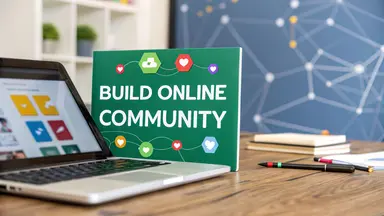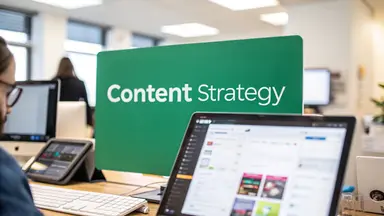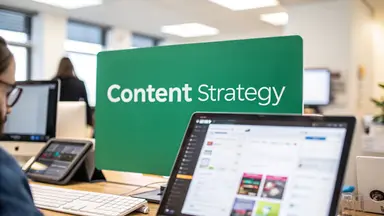Defining Your Community's Purpose and Vision

Before you write a single welcome post, we need to lay the groundwork. It all boils down to answering the most important question of all: why should this community even exist? Without a strong "why," a community is just a group chat that will eventually fizzle out.
Think of it like building a house. You wouldn't just start buying lumber without a detailed blueprint. Your community's purpose is that blueprint. It guides every single decision you'll make, from the kind of content you share to the moderation rules you set.
Clarifying Your Core Objective
So, what’s the main goal here? Be specific. A vague objective, such as "connecting with customers," is too broad to be useful. A more effective approach is to tie your community’s purpose directly to a measurable business outcome or a tangible benefit for your members.
For example, a software company might create a community to reduce support tickets by 20% by letting users help each other. A fitness coach could aim to increase client retention by 30% by creating a space where members can share their wins and stay motivated.
This clarity pays off. Brands with thriving communities report a 53% higher customer retention rate. It’s not just about loyalty, either; 76% of consumers say they are more likely to buy from a brand that has a strong community. The link between community and trust is undeniable.
> My Take: Your community's purpose shouldn't be a well-kept secret. It needs to be front and center—the headline on your sign-up page, the first thing people read in your welcome email, and the north star for all your content.
Understanding Your Ideal Member
Once you've nailed down your "why," it's time to get specific about your "who." To build a space where people truly feel they belong, you have to go way beyond basic demographics. You need to get inside their heads.
Ask yourself these kinds of questions about your ideal member:
What are their biggest struggles or pain points related to your niche?
What have they already tried that just didn't work for them?
What are their real aspirations? What does "success" look like in their world?
Where do they hang out online now? What kind of content do they love?
This exercise helps you move from a generic target audience to a detailed member persona. Instead of "small business owners," you might focus on "first-time e-commerce founders who are completely overwhelmed by marketing." That level of specificity is what allows you to build powerful community engagement strategies that work.
Crafting a Unique Value Proposition
Your value proposition is the promise you make to every potential member. It answers their silent question: "What's in it for me?" To stand out from all the noise online, this promise needs to be both compelling and unique.
Here’s a simple framework I've used that works wonders:
For [Your Ideal Member]
Who [Struggle with a Specific Problem]
Our Community Provides [The Solution or Benefit]
So That [They Can Achieve a Desired Outcome]
Let’s put it into practice. A community for freelance writers could say: "For new freelance writers who struggle to find high-paying clients, our community provides weekly job leads, proven proposal templates, and expert AMAs so that you can build a sustainable six-figure business."
See how clear and compelling that is? It’s an irresistible reason to join and sets the stage for a community built on shared goals and real support.
Choosing the Right Platform for Your Community
Picking the right platform is like choosing the plot of land where you'll build your community's home. This single decision shapes almost everything that comes after—how your members connect, how you can grow, and whether you can eventually monetize your efforts. It's a foundational piece of the puzzle when you're learning how to build a successful online community.
Your main choice boils down to a classic dilemma: "rented" vs. "owned" spaces. Think of rented platforms as setting up shop in a busy public square (like Facebook Groups or Discord), while owned platforms are like building your custom clubhouse from the ground up.
Rented Spaces: Quick Wins and Hidden Costs
Let's be honest, the appeal of a rented space is undeniable. Your members are probably already on platforms like Facebook or Discord, which makes getting started incredibly easy. You can spin up a new group or server in minutes, not days. It’s a fantastic way to get moving quickly.
But that convenience comes with some serious strings attached. You're building on borrowed land, and the landlord can change the rules at any time.
Limited Customization: You’re stuck with the platform’s look and feel, leaving little room to create a truly unique, branded experience for your members.
No Data Ownership: This is a big one. You don't own your member list or their data. If the platform changes its policies or you decide to leave, taking your community with you is nearly impossible.
Algorithmic Risk: Your community's reach lives and dies by an algorithm you don't control. An update you didn't see coming could completely tank your engagement overnight.
These platforms are great for getting off the ground fast or for short-term projects, like a 30-day fitness challenge. If speed is your top priority, they can be a perfect fit.
Owned Platforms: Control and Commitment
On the other hand, owned platforms—think dedicated forum software or a fully custom-built site—put you completely in charge. You control the entire experience: the branding, the features, the moderation rules, and, critically, all your member data.
This level of control means you can integrate your community directly with your products, create bespoke features, and build a space that feels like a true extension of your brand. You can even explore some of the top interactive video platforms for engagement to create a richer experience, something you just can't do in a standard Facebook Group.
> The biggest upside of an owned platform is sovereignty. You set the rules, you own the relationships, and you’re protected from the whims of social media giants. This is how you build a real, long-term digital asset.
Of course, with great power comes greater responsibility. Owned platforms demand more technical know-how to set up, often have subscription or development costs, and put the marketing burden squarely on your shoulders. There’s no built-in audience; you have to bring people to your door.
Making the Call: Rented vs. Owned
So, how do you decide? I find it helps to look at your resources, goals, and long-term vision. This isn't just a technical decision; it's a strategic one. To help you weigh the pros and cons, here's a side-by-side comparison.
Control & Customization
Owned Platforms (e.g., Forum Software): Complete control over branding, features, and rules.
Rented Platforms (e.g., Facebook Groups, Discord): Very limited; you’re bound by the platform’s design.
Data Ownership
Owned Platforms: You own all member data and communication.
Rented Platforms: The platform owns the data, and you have limited access.
Setup Cost & Time
Owned Platforms: Higher initial investment of time and money.
Rented Platforms: Free and incredibly fast to set up (often in minutes).
Member Discovery
Owned Platforms: You are responsible for all marketing and traffic.
Rented Platforms: Easier discovery, as members are already on the platform.
Long-Term Risk
Owned Platforms: Lower risk; you're in control of your destiny.
Rented Platforms: High risk; subject to algorithm changes and platform policy.
Monetization
Owned Platforms: Flexible and diverse options (subscriptions, ads, etc.).
Rented Platforms: Restricted by the platform’s terms of service.
Ultimately, there's no single "right" answer, only what's right for you right now. A startup on a shoestring budget might test the waters with a Discord server before committing to an owned platform. A well-established brand, however, should probably invest in an owned solution from day one to protect its customer relationships.
This decision is becoming more common as the global market for online community platforms grows. Valued at $736.9 million, it’s expected to hit $2.4 billion by 2033. That explosive growth signals a clear shift: more businesses are realizing the value of creating their own dedicated spaces for their audience.
This chart can help you visualize where your community might fit.

As you can see, simpler communities can do just fine with standard forum software. But as your needs grow more complex, a more custom, owned solution becomes the clear winner for long-term success.
Crafting a Content and Engagement Strategy

An empty community feels a lot like a party with no music—it just won't last. Once you've set up a home for your community, the real work begins: filling it with life. Your content is the reason people show up, but genuine engagement is what makes them stay, connect, and start contributing themselves.
The key is to shift your mindset from being a broadcaster to being a fantastic host. This isn't about a one-way monologue. It's about creating a sustainable rhythm of content that sparks real conversation and forges relationships, turning your space into a lively, member-driven dialogue.
Establishing Your Core Content Pillars
Instead of throwing random posts at the wall to see what sticks, think in terms of "content pillars." These are the handful of recurring themes or topics that your community can always expect from you. Sticking to three to five solid pillars makes content planning infinitely more manageable and gives your members a sense of comforting predictability.
Great content pillars flow directly from your community's core purpose. For example, a community built for photographers might lean on pillars like "Weekly Photo Critiques," "Gear Talk Tuesdays," and "Behind-the-Lens Stories."
Here are a few proven content ideas that I've seen work across countless niches:
Expert Q&As or "Ask Me Anything" (AMA) Sessions: Bring in an industry expert (or position yourself as one) for a live, interactive session. This delivers a huge amount of value and creates fantastic real-time buzz.
Member Spotlights: Make it a regular habit to feature a member's story, a cool project they're working on, or a recent success. People love to feel seen and celebrated, and it inspires others to step up and share, too.
Behind-the-Scenes Updates: Give your members an exclusive peek behind the curtain. Show them your process, a new product in development, or even a recent failure. This kind of transparency builds a surprising amount of trust and deepens the connection.
Weekly Themed Threads: Get a consistent, low-effort engagement loop going with recurring posts like "Motivation Monday" or "Wins Wednesday."
These pillars will become the backbone of your content calendar, making sure you're never scrambling for something valuable to post.
From Lurkers to Active Participants
In any community, especially a new one, you'll have more lurkers than active posters. Don't panic—that's completely normal. Your job is to make it incredibly easy and inviting for people to take that first small step from just observing to participating.
One of the most effective ways to do this is by seeding conversations. In the early days, you and maybe a few founding members will need to be the primary conversation starters. But don't just post and walk away. Actively tag a few people and ask for their specific opinions to gently pull them into the discussion.
> A personal rule I live by: never ask a question you don't genuinely want the answer to. People have a sixth sense for disingenuous engagement-bait posts. Ask things that show you truly care about your members' experiences, struggles, and opinions.
The way you ask questions is critical. Steer clear of simple yes/no questions. Instead, use open-ended prompts that encourage people to share stories and detailed responses.
Weak Question
Did you like our new feature?
Do you have any questions?
Are you having a good week?
Strong Question
What's the most creative way you've used our new feature so far?
What's one thing you're still struggling with that we could help solve?
What's one win—big or small—that you've had this week?
See the difference? The stronger questions invite a narrative, not just a one-word reply. This approach is fundamental to sparking real interaction. While these examples are framed for a community forum, the art of asking better questions applies everywhere. Many of these same principles are covered in these powerful Instagram engagement strategies, which you can easily adapt for your community platform.
Creating Community Rituals
The most memorable communities have their own distinct culture, often complete with inside jokes and shared rituals. These rituals are the special, recurring activities that truly bond members together and make the group feel less like an audience and more like a tribe.
Rituals don't need to be elaborate. They can be simple, consistent events that members start to anticipate and look forward to.
1. Onboarding Welcomes: Kick things off with a dedicated thread where new members introduce themselves using a fun, simple template. Make it a point to personally welcome every single new person by name.
2. Celebratory Milestones: Make a big deal when the community hits 100 members, then 500, and so on. Also, take the time to celebrate individual member milestones, like their first anniversary in the group.
3. Unique Hashtags or Lingo: Let a shared language develop naturally. Unique terms or hashtags that are specific to your community create a powerful feeling of being an insider.
These small, consistent actions are what build a strong foundation of belonging. They are the secret sauce that transforms a simple online group into a genuine community where people feel a real sense of ownership and connection. And that, after all, is the ultimate goal.
Kicking Off and Growing Your New Community
A strong launch does more than just get you members; it sets the entire tone for your community's future. The real goal isn't just to fill the space. It's to attract your first 100 true fans—those enthusiastic, high-quality members who will become the very foundation of everything you build. Getting that initial momentum is critical.
Your first promotional push should be aimed squarely at your warmest audience. These are the people who already know, like, and trust you. Think about your email list, your social media followers, and your website visitors. These channels are your launchpad, filled with people already engaged with your brand and most likely to want a deeper connection.
The Founding Members Campaign
You can make your launch feel like a genuinely exclusive event by creating a "founding members" campaign. This isn't just some marketing gimmick; it's a brilliant way to build a sense of urgency and make your first members feel truly special. The idea is to offer them a unique benefit for getting in on the ground floor, framed as a reward for their early belief in the project.
This exclusive offer could be something like:
A lifetime discount if you ever plan to charge for membership.
A unique "Founder" badge or special role within the community.
Direct access to you for a private onboarding call or a Q&A session.
When you craft your invitations, lead with the value. Don't just announce, "Hey, we have a new community!" Instead, try something like, "Be one of the first 100 founding members of [Community Name] and get direct access to our expert team to help you achieve [specific goal]." This approach frames joining as a can't-miss opportunity, not just another thing to sign up for.
Weaving Promotion into Your Customer Journey
Your promotional efforts shouldn't be a one-and-done event. For the best results, weave invitations into the natural flow of your customer journey. This creates a steady, organic stream of high-quality new members who are already invested in what you do.
For example, you could add a simple call-to-action in your email signature. Or, you might set up an automated email that invites new customers to join the community a few days after they make a purchase. It's the perfect moment to welcome them into your brand's world on a much deeper level.
> The most successful communities I've seen are promoted as an integral part of the business, not as an afterthought. Think of it as the next logical step for your best customers and biggest fans.
When it comes to getting the word out, you don't have to reinvent the wheel. You can learn from these proven strategies to effectively promote your community online and adapt them for your launch.
Finding Quality Members on Social Media
Social media is so much more than a simple announcement channel; it's where modern communities are often born and nurtured. With people spending over 14 billion hours on these platforms daily, it’s clear how ingrained they are in our lives. Platforms like TikTok, with its massive 2 billion monthly users, are especially powerful for discovery—a staggering 77% of Gen Z users use it to find new products and brands.
Your promotional content needs to tap into this behavior. Show off the unique value and culture of your community to attract members who genuinely care about your mission.
Your social strategy needs to be tailored to each platform. For a visual-heavy platform like Instagram, a behind-the-scenes look at the community or a member spotlight can work wonders. You can learn more about crafting this kind of content in our guide to social media marketing for Instagram. The key is to show, not just tell. Demonstrate the community’s value in action, giving potential members a clear reason to go from being a passive follower to an active participant.
Moderating and Measuring Community Health

As your community gets bigger, a hands-off approach simply won't cut it anymore. Think of solid moderation as your community's immune system—it’s what keeps the space safe, valuable, and positive. Without it, I’ve seen even the most promising groups spiral into chaos, pushing away the very members you worked so hard to get.
Don't think of governance as a bunch of restrictive rules. It’s a framework for healthy growth. You'll need a smart mix of proactive and reactive strategies to make sure your community remains a place where people actually feel comfortable and inspired to jump in.
Creating Clear and Fair Guidelines
Your community guidelines are the constitution for your online space. They need to be crystal clear, easy to find, and written in a voice that matches your community's vibe. Ditch the legal jargon; focus on simple dos and don’ts that encourage respectful conversations.
These rules aren't just for punishing bad behavior; they're for empowering good behavior. When members know the lay of the land, they feel more confident participating. A solid set of guidelines usually covers:
Respect and Kindness: A zero-tolerance policy for personal attacks, hate speech, or bullying is non-negotiable.
Staying on Topic: Gentle guardrails to keep discussions relevant and valuable for everyone.
No Spam or Self-Promotion: Define what you consider spam to protect the member experience from endless self-plugs.
Consequences: Be transparent about what happens when someone breaks a rule, whether it's a friendly warning or a permanent ban.
> A common mistake is burying your guidelines where no one can find them. Pin them to your main channel, pop them in the welcome email, and refer back to them. They should be a living document that everyone knows and respects.
Proactive vs. Reactive Moderation
Great moderation isn’t just about putting out fires—it’s about preventing them in the first place. This means you have to play both offense and defense.
Reactive moderation is what most people picture: deleting spammy posts, warning members who cross a line, and settling disputes. This is essential for keeping things in order.
Proactive moderation, on the other hand, is where you really get to shape the culture. This is the fun stuff—actively welcoming new people, shouting out fantastic contributions, and sparking interesting conversations. A good moderator is just as much a cheerleader as they are a referee. For community pros looking to level up, learning to master Notion membership management can be a game-changer for tracking member health and contributions at scale.
Moving Beyond Vanity Metrics
Once your community is up and running, it's so tempting to measure success with one big number: total members. But that's a classic vanity metric. Honestly, a community with 10,000 lurkers is far less healthy than one with 500 people who are actively talking and connecting.
To get a real pulse on your community's health, you have to look at numbers that show actual activity and connection. Taking a data-driven approach tells you what's working, what isn't, and where to focus your energy next.
These are the metrics that truly matter:
Activity Rates
What to Measure: Daily or Monthly Active Users (DAU/MAU).
Why It Matters: This shows how “sticky” your community is — in other words, are people coming back regularly?
Engagement Levels
What to Measure: Number of posts, comments, and likes per active user.
Why It Matters: It reveals how much real interaction is happening. Higher numbers indicate a lively, engaged, and chatty community.
Content Creation
What to Measure: User-Generated Content (UGC) Rate.
Why It Matters: This helps measure how many members are actively creating new content versus just consuming what’s already there.
Sentiment Analysis
What to Measure: Ratio of positive to negative keywords in user interactions.
Why It Matters: It helps you understand the overall mood of your community — are conversations mostly supportive, or do they tend to be argumentative?
Empowering Member Moderators
As you grow, you can't do it all yourself. Trust me, trying to moderate a large, busy community alone is a one-way ticket to burnout. The best solution? Empower your most passionate and helpful members to become moderators.
You can usually spot potential moderators a mile away. They're the ones already answering questions, welcoming newbies, and defending the community's values without anyone asking them to.
When you bring on member-moderators, you're doing more than just lightening your load. You're building a powerful sense of shared ownership. This is a crucial step toward building a community that's truly sustainable and driven by its members. Just be sure to give them a private channel to chat, clear guidance, and your full support. They're the future leaders of the community you’ve built.
Got Questions? We've Got Answers
When you're diving into building an online community, a lot of questions pop up. It's normal. I've been there, and I've seen hundreds of others go through it, too. Let's tackle some of the most common hurdles with real-world, no-fluff answers.
How Long Does This Take?
Let's be real: there's no magic switch. Building a real, thriving community takes time. You should realistically expect it to take 6-12 months to really get a solid foundation—a core group of people who show up and a rhythm that feels natural.
The goal isn't a viral explosion overnight. It's about consistent, patient effort. In those early days, forget about the member count. Your focus should be on creating a space that feels safe, interesting, and genuinely welcoming. Success comes from showing up every day, sparking conversations, and making sure the right people find their way to you.
> My advice? Obsess over the small wins. Get excited about your first 10 members. Celebrate when you hit 50. True momentum is born from deep engagement with a small, passionate group. Once you have that, the growth will feel much more natural.
Should I Make People Pay to Join?
This is the big one, isn't it? The answer comes down to what you're offering. Charging for access can be a fantastic move, but only if the value is undeniable.
Free communities are perfect for building brand awareness and providing customer support. Think of them as the friendly front porch of your brand, where anyone can stop by.
Paid communities succeed when they offer something exclusive that people can't just find on Google. We're talking about premium content, direct access to you or other experts, high-level networking, or unique tools.
Before putting up a paywall, ask yourself this one simple question: "Is what I'm offering so valuable that someone would happily pull out their credit card for it every single month?" If you can't say "hell yes!" to that, stick with a free model for now.
Okay, I Just Launched. What Do I Do First?
The first few hours and days after launch are everything. This is your chance to set the tone and make your earliest members feel like they've just walked into the best party in town.
Here’s your immediate game plan:
1. Welcome People Personally: An automated message is cold. Post a genuine welcome in the main feed, tag new members by name, and prompt them to share a little about themselves.
2. Get the Conversation Started: Don't wait for silence to settle in. Have a few interesting questions or prompts ready to go. You're the host—it's your job to get people talking and show them what participation looks like.
3. Shine a Spotlight on Contributors: The moment someone makes a great post or asks a smart question, celebrate them! Publicly thank them. This is positive reinforcement that encourages everyone else to jump in.
These first moves create a cycle of positive energy and prove the value of joining right from the get-go.
How Do I Keep People from Getting Bored and Leaving?
Long-term engagement is about one thing: evolution. A community that never changes will die. To keep people invested, your space needs to grow and adapt with them.
Make a habit of asking for feedback. Run polls, start discussion threads, or just send a few DMs. What do they love? What are they tired of? Use that intel to introduce new things—maybe a member-led workshop, an "ask me anything" session with an expert, or a collaborative project.
And don't forget to empower your power users. Those people who are always showing up? Give them a special role, moderator permissions, or early access to new features. When your most dedicated members feel a sense of ownership, they become your partners in building something truly special.
Ready to attract the right people for your Instagram community? With Gainsty, you can grow your audience with real, organic followers who care about what you do. Our AI-powered platform and expert strategies help you gain more engagement—no bots, no fake accounts. Start building your authentic following today and watch your community come to life.















